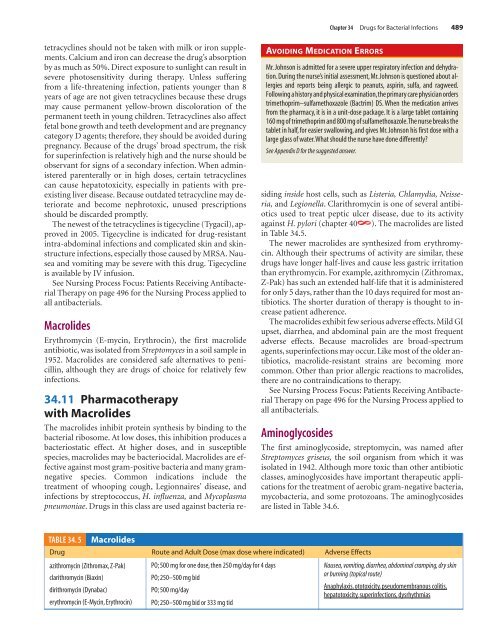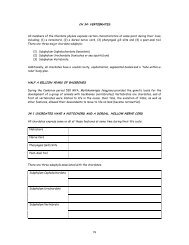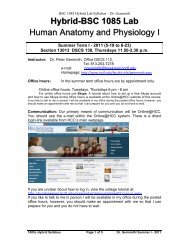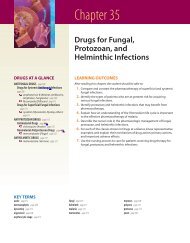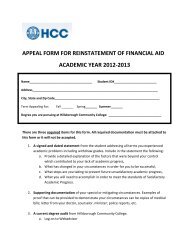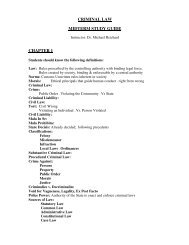Antimicrobial Drugs
Antimicrobial Drugs
Antimicrobial Drugs
You also want an ePaper? Increase the reach of your titles
YUMPU automatically turns print PDFs into web optimized ePapers that Google loves.
M34_ADAM9811_03_SE_CH34.QXD 12/30/09 1:16 PM Page 489<br />
Chapter 34 <strong>Drugs</strong> for Bacterial Infections 489<br />
tetracyclines should not be taken with milk or iron supplements.<br />
Calcium and iron can decrease the drug’s absorption<br />
by as much as 50%. Direct exposure to sunlight can result in<br />
severe photosensitivity during therapy. Unless suffering<br />
from a life-threatening infection, patients younger than 8<br />
years of age are not given tetracyclines because these drugs<br />
may cause permanent yellow-brown discoloration of the<br />
permanent teeth in young children. Tetracyclines also affect<br />
fetal bone growth and teeth development and are pregnancy<br />
category D agents; therefore, they should be avoided during<br />
pregnancy. Because of the drugs’ broad spectrum, the risk<br />
for superinfection is relatively high and the nurse should be<br />
observant for signs of a secondary infection. When administered<br />
parenterally or in high doses, certain tetracyclines<br />
can cause hepatotoxicity, especially in patients with preexisting<br />
liver disease. Because outdated tetracycline may deteriorate<br />
and become nephrotoxic, unused prescriptions<br />
should be discarded promptly.<br />
The newest of the tetracyclines is tigecycline (Tygacil), approved<br />
in 2005. Tigecycline is indicated for drug-resistant<br />
intra-abdominal infections and complicated skin and skinstructure<br />
infections, especially those caused by MRSA. Nausea<br />
and vomiting may be severe with this drug. Tigecycline<br />
is available by IV infusion.<br />
See Nursing Process Focus: Patients Receiving Antibacterial<br />
Therapy on page 496 for the Nursing Process applied to<br />
all antibacterials.<br />
Macrolides<br />
Erythromycin (E-mycin, Erythrocin), the first macrolide<br />
antibiotic, was isolated from Streptomyces in a soil sample in<br />
1952. Macrolides are considered safe alternatives to penicillin,<br />
although they are drugs of choice for relatively few<br />
infections.<br />
AVOIDING MEDICATION ERRORS<br />
Mr. Johnson is admitted for a severe upper respiratory infection and dehydration.<br />
During the nurse’s initial assessment, Mr. Johnson is questioned about allergies<br />
and reports being allergic to peanuts, aspirin, sulfa, and ragweed.<br />
Following a history and physical examination,the primary care physician orders<br />
trimethoprim–sulfamethoxazole (Bactrim) DS. When the medication arrives<br />
from the pharmacy, it is in a unit-dose package. It is a large tablet containing<br />
160 mg of trimethoprim and 800 mg of sulfamethoxazole.The nurse breaks the<br />
tablet in half, for easier swallowing, and gives Mr. Johnson his first dose with a<br />
large glass of water.What should the nurse have done differently?<br />
See Appendix D for the suggested answer.<br />
34.11 Pharmacotherapy<br />
with Macrolides<br />
The macrolides inhibit protein synthesis by binding to the<br />
bacterial ribosome. At low doses, this inhibition produces a<br />
bacteriostatic effect. At higher doses, and in susceptible<br />
species, macrolides may be bacteriocidal. Macrolides are effective<br />
against most gram-positive bacteria and many gramnegative<br />
species. Common indications include the<br />
treatment of whooping cough, Legionnaires’ disease, and<br />
infections by streptococcus, H. influenza, and Mycoplasma<br />
pneumoniae. <strong>Drugs</strong> in this class are used against bacteria residing<br />
inside host cells, such as Listeria, Chlamydia, Neisseria,<br />
and Legionella. Clarithromycin is one of several antibiotics<br />
used to treat peptic ulcer disease, due to its activity<br />
against H. pylori (chapter 40 ). The macrolides are listed<br />
in Table 34.5.<br />
The newer macrolides are synthesized from erythromycin.<br />
Although their spectrums of activity are similar, these<br />
drugs have longer half-lives and cause less gastric irritation<br />
than erythromycin. For example, azithromycin (Zithromax,<br />
Z-Pak) has such an extended half-life that it is administered<br />
for only 5 days, rather than the 10 days required for most antibiotics.<br />
The shorter duration of therapy is thought to increase<br />
patient adherence.<br />
The macrolides exhibit few serious adverse effects. Mild GI<br />
upset, diarrhea, and abdominal pain are the most frequent<br />
adverse effects. Because macrolides are broad-spectrum<br />
agents, superinfections may occur. Like most of the older antibiotics,<br />
macrolide-resistant strains are becoming more<br />
common. Other than prior allergic reactions to macrolides,<br />
there are no contraindications to therapy.<br />
See Nursing Process Focus: Patients Receiving Antibacterial<br />
Therapy on page 496 for the Nursing Process applied to<br />
all antibacterials.<br />
Aminoglycosides<br />
The first aminoglycoside, streptomycin, was named after<br />
Streptomyces griseus, the soil organism from which it was<br />
isolated in 1942. Although more toxic than other antibiotic<br />
classes, aminoglycosides have important therapeutic applications<br />
for the treatment of aerobic gram-negative bacteria,<br />
mycobacteria, and some protozoans. The aminoglycosides<br />
are listed in Table 34.6.<br />
TABLE 34. 5<br />
Macrolides<br />
Drug Route and Adult Dose (max dose where indicated) Adverse Effects<br />
azithromycin (Zithromax, Z-Pak) PO; 500 mg for one dose, then 250 mg/day for 4 days Nausea, vomiting, diarrhea, abdominal cramping, dry skin<br />
clarithromycin (Biaxin)<br />
PO; 250–500 mg bid<br />
or burning (topical route)<br />
dirithromycin (Dynabac)<br />
PO; 500 mg/day<br />
Anaphylaxis, ototoxicity, pseudomembranous colitis,<br />
hepatotoxicity, superinfections, dysrhythmias<br />
erythromycin (E-Mycin, Erythrocin) PO; 250–500 mg bid or 333 mg tid<br />
# 102887 Cust: PE/NJ/CHET Au: ADAMS Pg. No. 489<br />
Title: Pharmacology for Nurses Server: Jobs2<br />
C/M/Y/K<br />
Short / Normal<br />
DESIGN SERVICES OF<br />
S4CARLISLE<br />
Publishing Services


